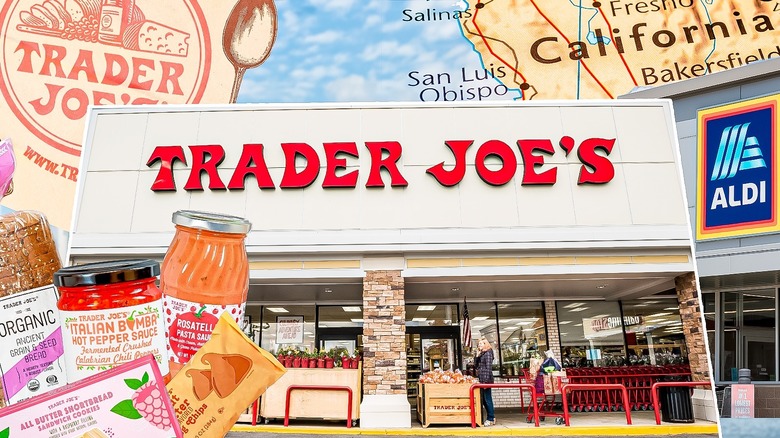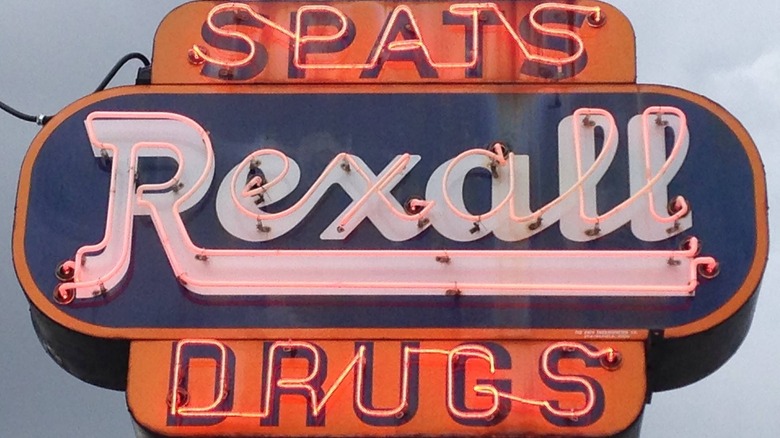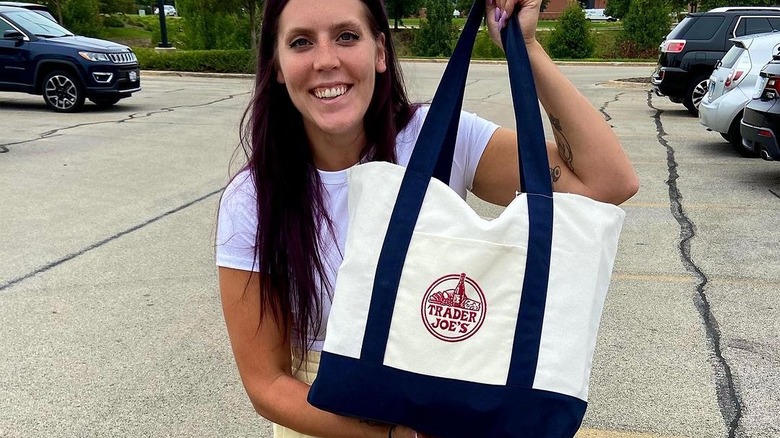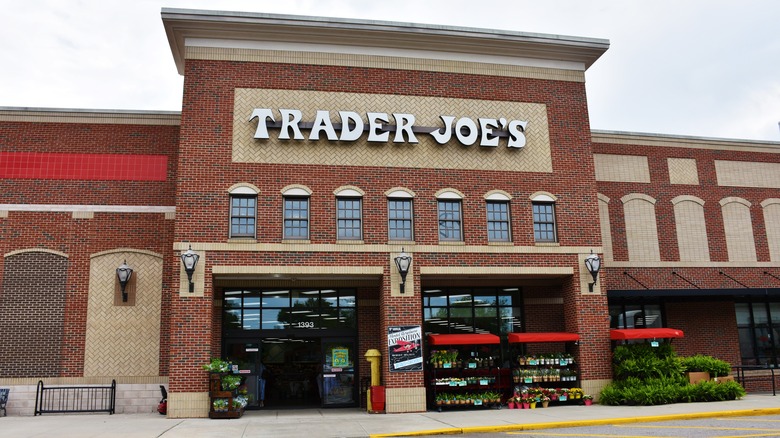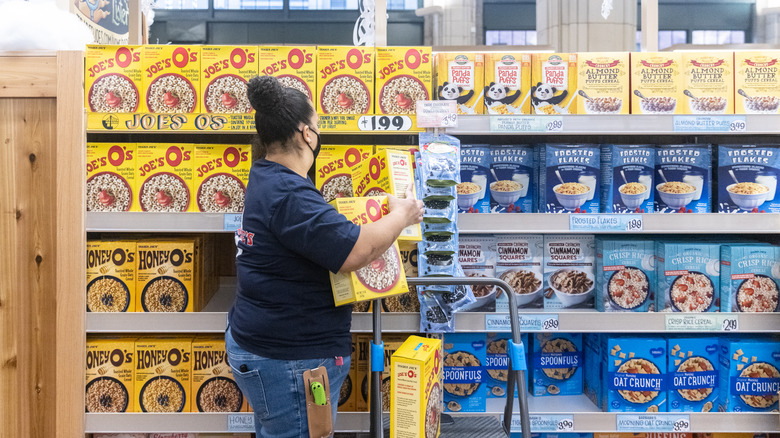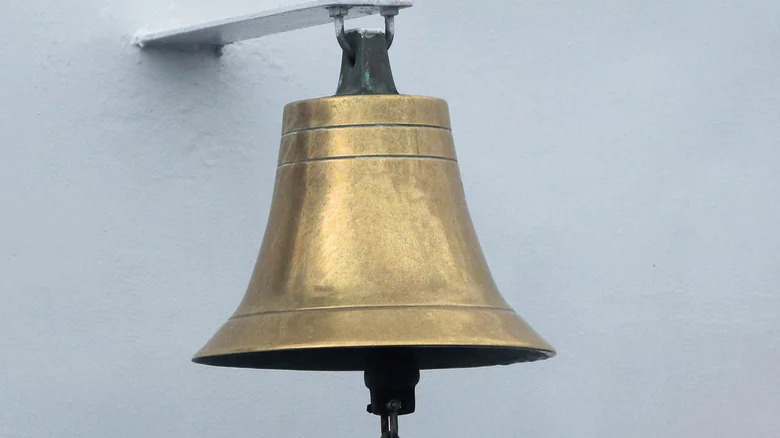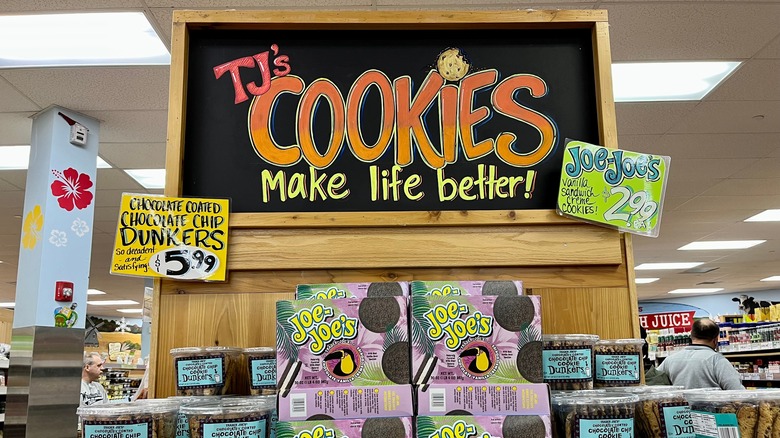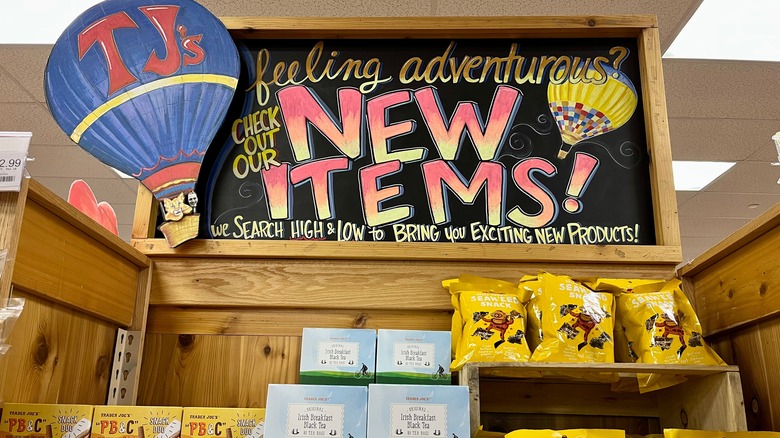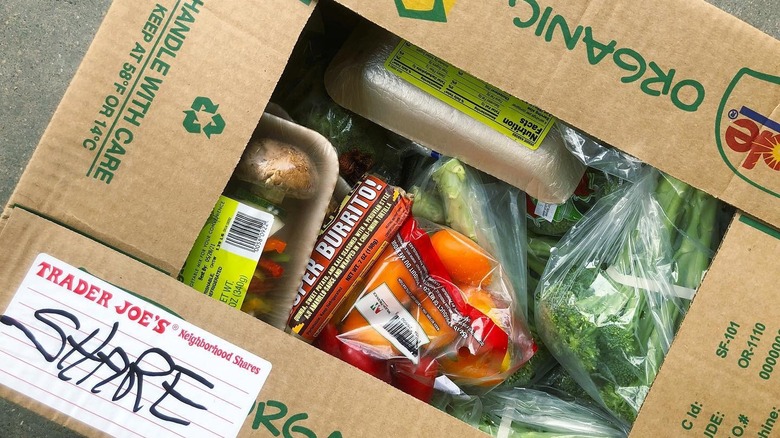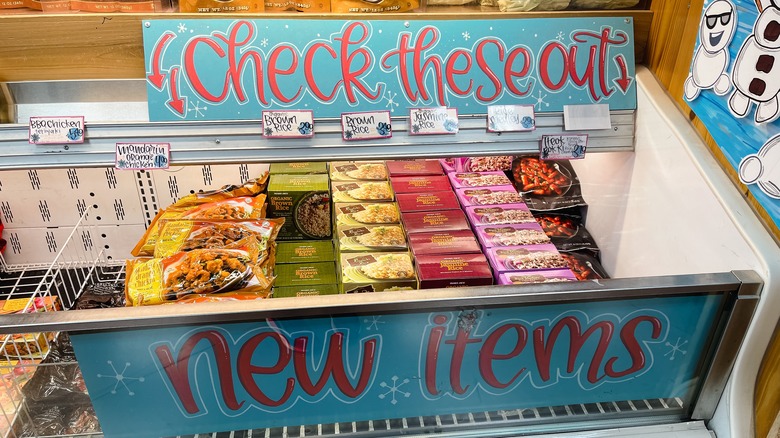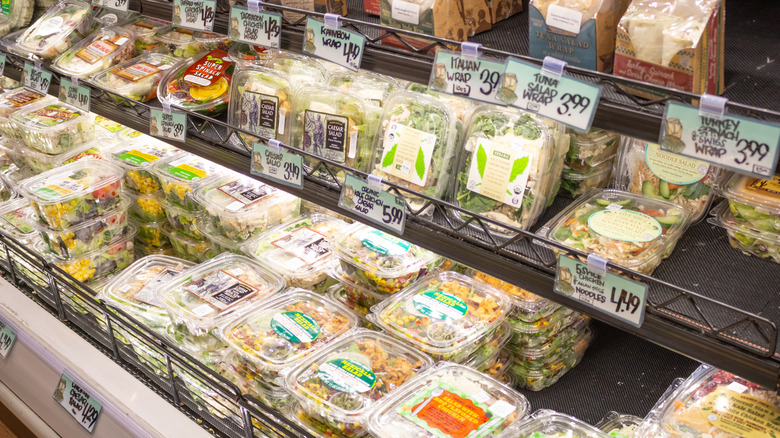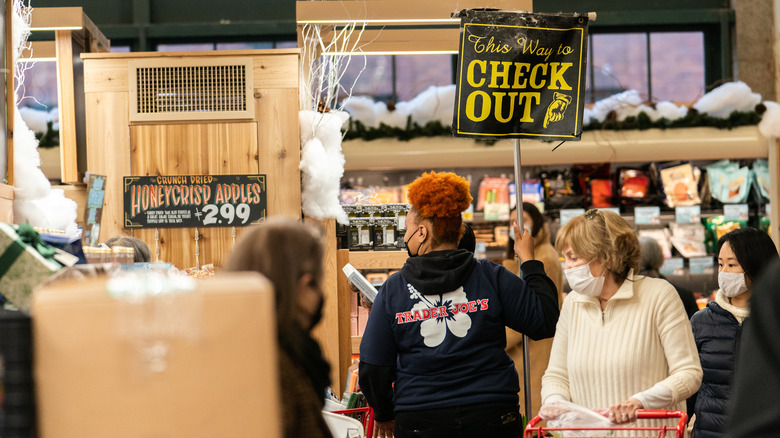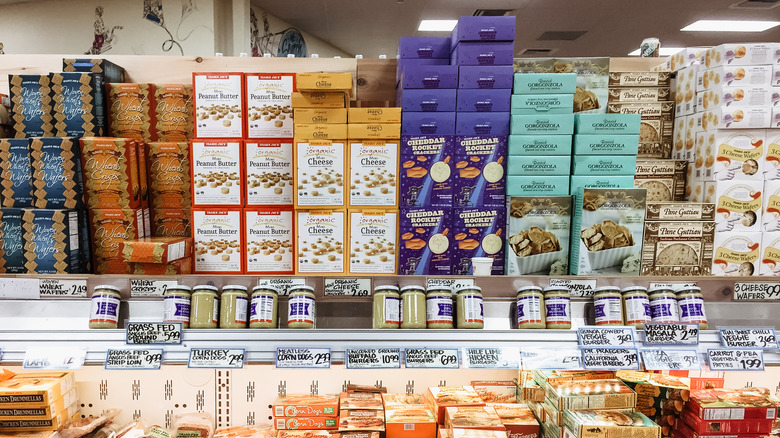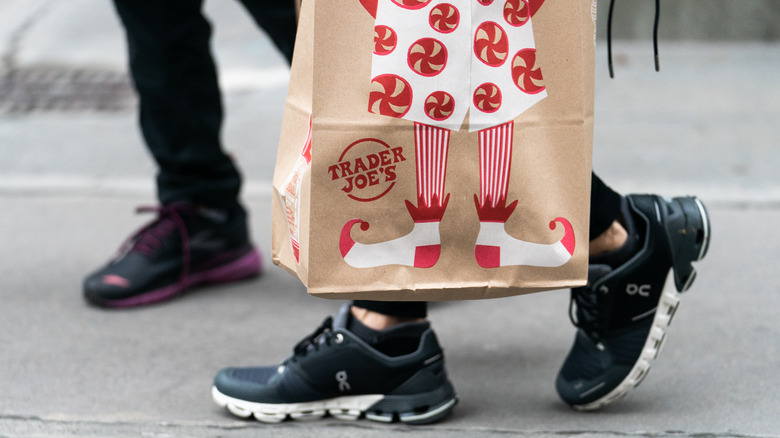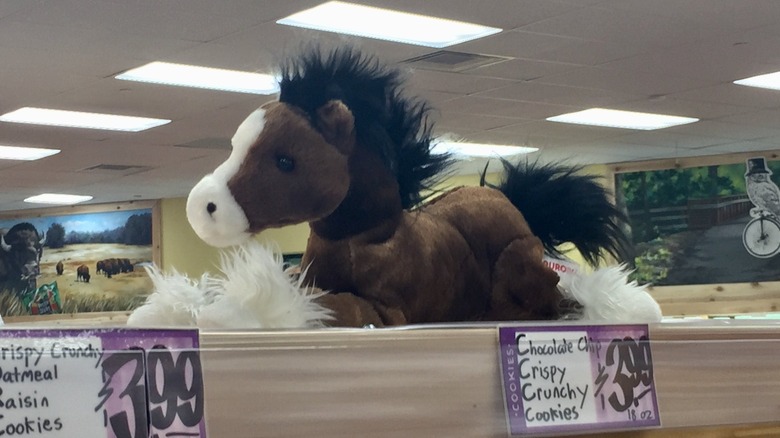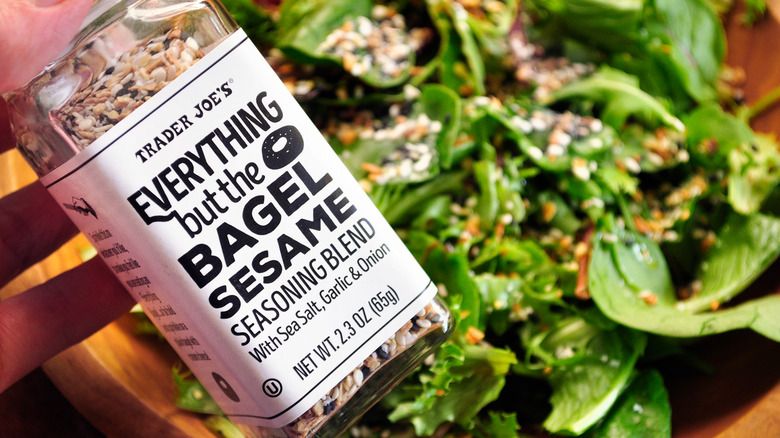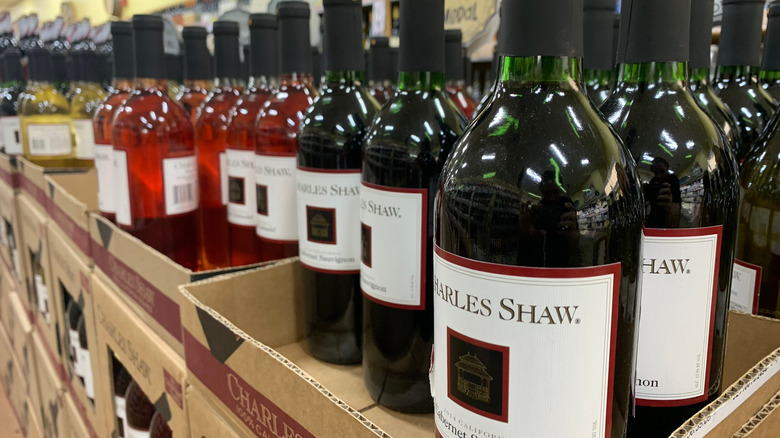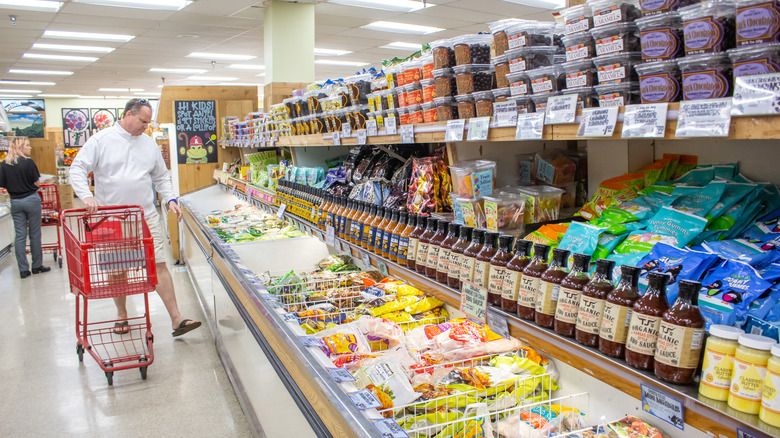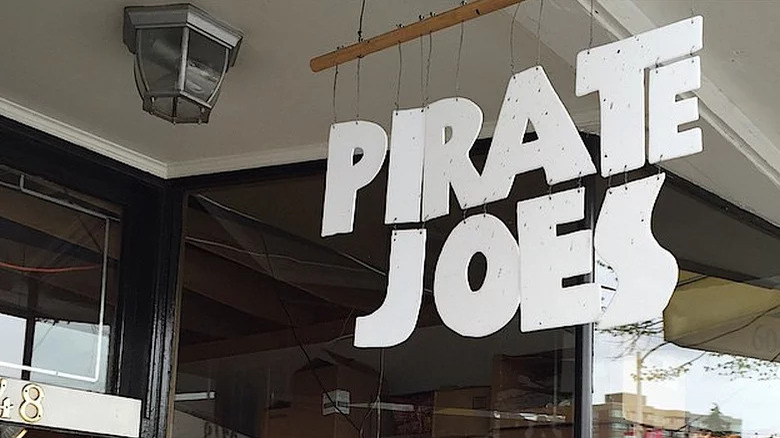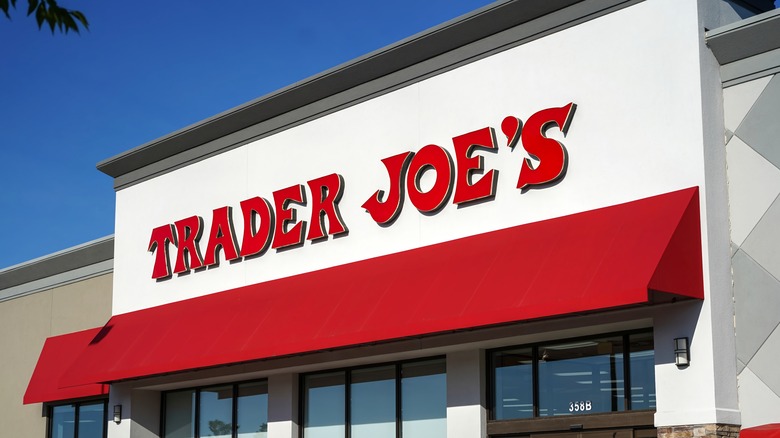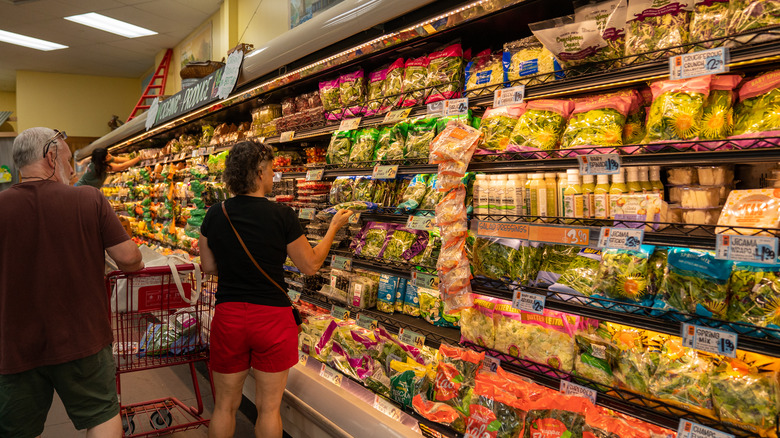25 Facts About Trader Joe's You Should Know As A Super Fan
Trader Joe's offers a truly unique shopping experience. Walking through its doors transports you into the vibe of a friendly seaside marketplace with super helpful merchants. It perfectly combines the small-town feel of a mom-and-pop store with the product selection of a major chain; penny pinchers and diet splurgers alike can shop proudly there. Where else can you find hidden stuffed animals for curious kids to discover? Or even better, overindulge on delicious seasonal products? Trader Joe's is a world within itself.
When you're there, leave your expectations behind and enjoy the cozy, nautical vibes. From its focus on sustainability and customer service to its affordable pricing and liberal position on refunds, Trader Joe's is one of the most popular grocery store chains in the United States for a reason. Despite being a hugely popular brand, it's somehow managed to retain the neighborhood essence that made it a household name. If you already love it, you'll become a super fan after you learn these interesting facts about Trader Joe's.
Trader Joe is a literal person
Yes, Trader Joe was an actual living, breathing human being. His name was Joe Coulombe, and he owned a convenience store in Los Angeles before slow business inspired him to open a grocery store chain. The name itself was inspired by Trader Vic's, a notable Tiki Bar located in California, while the aquatic theme is meant to transport you to the South Seas. Trader Joe's officially opened in Pasadena, California, in 1967. Like Coulombe, who lived to the age of 89, Trader Joe's has enjoyed a long life. A memoir detailing his incredible story, called "Becoming Trader Joe," was published in 2021.
Trader Joe's originally opened as a convenience store
Trader Joe's wasn't always a one-stop destination for international palates. The original 1967 brick-and-mortar location was a convenience store called "Pronto Markets" first. Joe Coulombe purchased it from Rexall, a pharmacy company that had previously operated several throughout the area. As business declined, Rexall decided to shutter the stores, giving Coulombe the opportunity to purchase the location he was managing. Rather than an eclectic selection of foods, the original Trader Joe's continued to be a convenience store for some time before rebranding into the special grocery store we've all come to love.
Trader Joe's is a reusable bag pioneer
In today's sustainability-conscious world, the thought of being asked, "Paper or plastic?" has become an alien concept. As normal as reusable bags are to us now, they are only a recent addition to the grocery shopping experience. You'll be surprised to learn that Trader Joe's was the first grocer to offer reusable bags. They were introduced in 1977 and had the phrase "save-a-tree" printed on them. The bag is an iconic part of the Trader Joe's brand and is still sold in stores today. Reusable bags didn't start catching on until the 1990s.
California is the Trader Joe's capital
With Pasadena giving birth to Trader Joe's, it's only right that California is home to the highest number of locations. There are a staggering 193 TJ's spread throughout the Golden State, which according to data aggregator Scrape Hero, amounts to one store for every 204,725 California residents. Even more impressive, it makes up around 34% of the company's entire store count. New York is the runner-up but only hosts 6%; a paltry 33 locations. It wasn't until 1993 that TJ's opened its first brick-and-mortar outside of California, in Arizona. Today, there are stores in 44 U.S. states.
Aldi is actually the calling the shots
Besides the noticeable similarities between the two, Trader Joe's and German-brand Aldi have more in common than one might expect. Originally a single company owned by brothers Karl and Theo Albrecht, Aldi later broke into two separate entities after a dispute over whether or not to sell cigarettes caused a split: There's now Aldi Nord, in charge of all U.S.-based Trader Joe's operations, and Aldi Süd, which owns and runs all U.S.-based Aldi operations. TJ's was purchased from Joe Coulombe by Aldi Nord in 1979. Despite their close connection, Trader Joe's and Aldi serve fairly distinct demographics.
Unlock amazing benefits as a TJ's employee
Trader Joe's has a reputation for offering employees a wide range of benefits. Beyond competitive hourly pay, crew members can receive two raises each year. A performance review determines the amount of the pay increase. The store chain offers paid time off, too, which increases as crew members accrue tenure. Even for new hires, Trader Joe's kickbacks 3.6% of your hourly pay into a paid time-off account. It can increase to a 7.5% kickback depending on how long you remain employed. In addition to those impressive perks, employees also receive a 401(k) retirement option, a 20% discount on all store products, health coverage, and opportunities for promotion.
All employee job positions are nautical-inspired
When Joe Coulombe envisioned Trader Joe's back in the day, he wanted to change the entire grocery shopping experience. He said he was inspired by a book called "White Shadows in the South Seas" written by Frederick O'Brien, along with a trip he made to Disneyland. The visionary founder wanted TJ's to be an immersive, themed experience, and he succeeded: Job positions carry nautical-themed titles like crew member (sales staff), mates (supervisors), and captains (managers). From wooden helms and fishing nets to plastic lobsters and Hawaiian shirts, Trader Joe's is a world away from your average supermarket.
For TJ's employees, the bell tolls
While perusing Trader Joe's selection of international goods, you may wonder what the ringing bells actually mean. The rings are how employees communicate with each other. Unlike white noise-filled intercoms found at most grocers announcing "cleanup on aisle three" or asking for help at the registers, the bells are a far less interruptive way to deliver a message and also add to TJ's maritime theme. Called "Trader Joe's Morse Code," the number of times a bell rings determines the message sent: One bell directs crew members to open an inactive register, two bells are for customers with questions, and three bells call in managers.
Employees get to hand-paint store signage
Another fun part of the Trader Joe's experience is the wonderfully hand-painted store signage. At each location, crew members who express interest in art are given the opportunity to create customized signage. Colorfully unique, the signage adds a personal touch to the store that distinguishes it from other locations. Along with signage, local artists are hired to beautify the walls with painted murals that incorporate a bit of the surrounding community's history, which adds to the overall neighborhood feel. Trader Joe's likes to foster a creative environment and gives crew members the freedom to express their vision.
Trader Joe's is an affordable price haven
Another way that Trader Joe's stands out from other grocers is its perpetually affordable pricing. The company's F.A.Q. says that it does not offer any discounts, coupons, gift card offers, or special promotions — and that applies to in-store and online sales. The goal is to offer appealing prices to customers every day. As a result, outside organizations have gained a reputation for using Trader Joe's name without permission to promote special discount offerings. According to an announcement on its website, TJ's actively works to disassociate itself from misleading promotions. The way they keep prices so low is by cutting out the middleman and buying products directly from their suppliers. In 2018, 80% of its products were made for Trader Joe's private label.
Charity is woven into the Trader Joe's fabric
When it comes to giving to the community, Trader Joe's is the most charitable grocer around. In the past year alone, the company donated over $469 million worth of its products to nonprofit partners nationwide. Giving to the community has been an important part of Trader Joe's manifesto since the beginning. As part of the Neighborhood Shares Program, it donates 100% of unsold products to those in need of food assistance. Through the national food security organization Feeding America, Trader Joe's has donated more than 104 million pounds of food in the United States to date. How Trader Joe's deals with its unsold food is a model for other grocery stores to follow — and sure enough, chains like Walmart and Whole Foods Market have also announced food donation plans.
Trader Joe's keeps a revolving door of new products
Trader Joe's shelves are stocked with a diverse selection, which allows the store to cater to a wide audience. Despite that variety, Trader Joe's locations, on average, stock far fewer products than their larger supermarket counterparts. To compensate for stocking fewer products, TJ's frequently discontinues items and often introduces new ones. That's why we had to say goodbye to discontinued Trader Joe's items like their pulled chicken, Island Salsa, and gluten-free cornbread. Seasonal availability also impacts what the store carries. What produce you find in a Trader Joe's, for example, is usually determined by what's in season. And the boxed goods on shelves change seasonally, too, as anything that's not a staple product is in danger of being dropped from shelves at the end of a season. Furthermore, a tasting panel works diligently behind the scenes to ensure only the best items hit the shelves.
Try nearly anything at Trader Joe's
Everybody thinks about taste-testing food products while at the grocery store. With that being against most stores' policies, we've all taken a leap of faith on an untested food item before, only to fall victim to a bad product with deceptively good branding. You'll be surprised to find that Trader Joe's has a "Try Anything" policy. A crew member will not only let you taste a product if you ask, but the company encourages it. Of course, it does not apply to raw meats, dried foods, frozen foods, and alcoholic beverages, but it's a free-for-all beyond that. Or at least, it's supposed to be. The store has definitely tightened up its encouraging "Try Anything" policy since the COVID-19 pandemic, but there's still a cost-effective way for you to try new Trader Joe's items.
Every item is pretty much refundable
Trader Joe's lets you return pretty much anything. You don't have to worry about forgetting to bring your receipt after driving across town to return that artichoke dip. Even without one, almost any item is eligible for a refund — the rule applies to open, partially eaten, and non-food products. Although a receipt is a no-hassle way to receive a refund, you only have to mention that you didn't enjoy your peanut butter brookie. Even more curious, rumor has it that you don't even need to bring the item you're returning in with you, but definitely call ahead and check first.
Many of Trader Joe's products are white-labeled
How does such a small grocer stock its shelves with so many delicious products? Thinly veiled behind its iconic product labels lies a hidden secret. Most of what's sold at Trader Joe's is made by big-name brands commonly found at other major chains. It's a business practice called "white-labeling" and involves rebranding products made by another company as their own. White-labeling removes the need for developing new, unique recipes and also cuts the need for advertising, which reduces business expenses by saving marketing dollars. The grocer keeps its partners under wraps, despite efforts by fans to uncover who makes Trader Joe's food.
Customers can reserve low-stock items
Although you won't find mainstream brands at Trader Joe's, it carries many products that customers swear by. Classics like Everything but the Bagel Sesame Seasoning Blend and Mediterranean Style Hummus remain on the radar of shoppers. As a result, they can sometimes run out of stock before you can get your hands on them. Thankfully, Trader Joe's employees are willing to set an item to the side if you ask politely. Although there is no ideal time to shop at Trader Joe's, as with many supermarkets, the best time of day would be to call in the morning to reserve an item when the store receives shipments.
Receive rewards for reusing your shopping bag
Keeping its commitment to sustainability, Trader Joe's rewards customers who reuse their shopping bags. You can receive money back in two ways. One reward option is $0.05 cashback for each reusable bag that you bring, while the other offer is entry into a weekly raffle to win a Trader Joe's gift card valued at $25. These deals vary by location, but you can call ahead to find out which reward is offered by the TJ's near you. Besides money rewards, it's simply the right thing to do for our environment.
Find hidden stuffed animals and win prizes
The immersive shopping experience offered at Trader Joe's goes beyond its maritime aesthetic. To create even more dynamic immersion and have a little fun, the company decided to invent a game for parents with accompanying children. If you can remember, apart from riding on the back of shopping carts, trudging along with your parents while they shop isn't the most exciting thing to do. Crew members inject fun into the Trader Joe's experience for kids by hiding a stuffed animal somewhere in the store. Any young treasure hunter who can find it receives a prize. Not every store participates in the game, and the prizes can vary.
The Trader Joe's reseller market is alive and well
Exclusivity is a big part of what makes Trader Joe's products so sought after. Unlike many major grocers, the company doesn't offer its products for sale online, which is unfortunate for people who live in towns or states without Trader Joe's locations. TJ's has become so popular over the years that it's attracted a fervent fanbase, both in the U.S. and abroad, and a network cropped up to service that market. With potential customers desperate for the supermarket's hyped line of products, resellers took advantage of the opportunity and created a black market that ships hard-to-find items overseas. If you see Trader Joe's products on Amazon and Walmart, you can rest assured that resellers are behind it.
Charles Shaw is an affordably priced best-seller
Perhaps the most iconic low-cost wine around, Charles Shaw is a ubiquitous part of the Trader Joe's lore. It represents everything the brand stands for: quality products for an affordable price. Nicknamed "Two Buck Chuck" (or "Three Buck Chuck" adjusted for inflation), it's the store's premiere in-house wine offering. We'd be remiss to not clarify that it's nowhere near top-shelf quality wine, but for a few bucks, it'll certainly get the job done. The best part is that, with seven wine varieties to choose from, none of your future get-togethers will ever bore.
Trader Joe's granola wasn't only for hippies
When opening a grocery store, it can't be easy to decide which product to sell first. A pioneer in many ways, Trader Joe's chose granola as its first product offering. This was during an era when it was considered a snack for hippies, an unpopular subsect of society at the time. Despite its connection to the counterculture, granola was the perfect snack for the type of well-traveled and educated customers that owner Joe Coulombe had in mind. If we didn't know any better, Coulombe's middle name could be "ahead of the curve" because today, granola is enjoyed by people from all areas of society and is one of the most popular breakfast foods in North America.
New product offerings are globally sourced
One of the hallmarks of Trader Joe's is the variety of international foods the grocery store stocks. The brand employs specialty buyers to search for these foods far and wide. Once the buyers find new and interesting products, they are subjected to a rigorous taste test to secure a coveted spot on the shelves. The final determination depends on the price at which Trader Joe's can sell a product. If it passes with flying colors, it's likely to end up in The Fearless Flyer, TJ's monthly newsletter.
A former customer created a Trader Joe's clone
Trader Joe's fans are so crazed that a customer once decided to open a Canadian rival humorously named "Pirate Joe's." Mike Hallat was his name, an entrepreneur who thought it was a genius idea to open a store that resold some of TJ's most coveted items. The most surprising part of it all is that it wasn't illegal. Hallat would adventure across the U.S.-Canadian border, purchase Trader Joe's products in bulk, and drive back to sell them in his own shop. It only took a year for Trader Joe's to hit him with a lawsuit, but despite its efforts, Hallat managed to keep Pirate Joe's open until he was forced to settle in 2017.
Only high-income neighborhoods have Trader Joe's locations
With over 500 stores throughout the nation, Trader Joe's caters to a massively loyal following. The company's fewer locations have fueled a demand for new stores, but that doesn't necessarily qualify any neighborhood to have one. According to an analysis by Aggdata, Trader Joe's tends to open stores in neighborhoods where the household median income is around $10,000 above the average, per the "Freakonomics" podcast. (As of 2022, Nerdwallet reports that the national median household income is $74,580.) Business interests aside, TJ's generally chooses locations in the cheapest part of those areas.
Trader Joe's offers fewer products to spur demand
As a smaller grocer, Trader Joe's carries fewer products than most major supermarkets. The average location stocks around 4,000 products compared to the 40,000 carried at other popular chains. With a massive number of 75 million stock keeping units (SKUs), behemoth retailer Walmart overshadows it completely, via Retail Wire. Exclusivity plays a mind trick on customers, and as a strategy, it has proven successful for many businesses. Avoiding brand names and expensive marketing budgets enables Trader Joe's to continue offering its products for low prices, and that keeps customers coming in.
